The content of this website is no longer being updated. For information on current assessment activities, please visit http://www.globalchange.gov/what-we-do/assessment
Great Plains
Observed and Projected Temperature Rise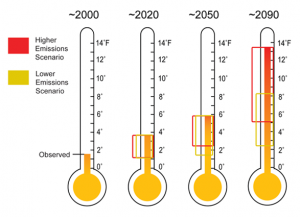 The average temperature in the Great Plains already has increased roughly 1.5°F relative to a 1960s and 1970s baseline. By the end of the century, temperatures are projected to continue to increase by 2.5°F to more than 13°F compared with the 1960 to 1979 baseline, depending on future emissions of heat-trapping gases. The brackets on the thermometers represent the likely range of model projections, though lower or higher outcomes are possible. Image Reference: CMIP3-A1The Great Plains is characterized by strong seasonal climate variations. Over thousands of years, records preserved in tree rings, sediments, and sand deposits provide evidence of recurring periods of extended drought (such as the Dust Bowl of the 1930s) alternating with wetter conditions.2,3
The average temperature in the Great Plains already has increased roughly 1.5°F relative to a 1960s and 1970s baseline. By the end of the century, temperatures are projected to continue to increase by 2.5°F to more than 13°F compared with the 1960 to 1979 baseline, depending on future emissions of heat-trapping gases. The brackets on the thermometers represent the likely range of model projections, though lower or higher outcomes are possible. Image Reference: CMIP3-A1The Great Plains is characterized by strong seasonal climate variations. Over thousands of years, records preserved in tree rings, sediments, and sand deposits provide evidence of recurring periods of extended drought (such as the Dust Bowl of the 1930s) alternating with wetter conditions.2,3
Today, semi-arid conditions in the western Great Plains gradually transition to a moister climate in the eastern parts of the region. To the north, winter days in North Dakota average 25°F, while it is not unusual to have a West Texas winter day over 75°F. In West Texas, there are between 70 and 100 days per year over 90°F, whereas North Dakota has only 10 to 20 such days on average.
Significant trends in regional climate are apparent over the last few decades. Average temperatures have increased throughout the region, with the largest changes occurring in winter months and over the northern states. Relatively cold days are becoming less frequent and relatively hot days more frequent.4 Precipitation has also increased over most of the area.5,6
Summer Temperature Change by 2080-2099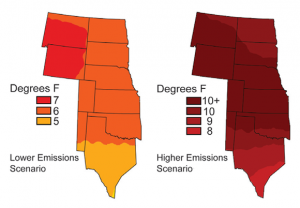 Temperatures in the Great Plains are projected to increase significantly by the end of this century, with the northern part of the region experiencing the greatest projected increase in temperature. Image Reference: CMIP3-B7Temperatures are projected to continue to increase over this century, with larger changes expected under scenarios of higher heat-trapping emissions as compared to lower heat-trapping emissions. Summer changes are projected to be larger than those in winter in the southern and central Great Plains.8 Precipitation is also projected to change, particularly in winter and spring. Conditions are anticipated to become wetter in the north and drier in the south.
Temperatures in the Great Plains are projected to increase significantly by the end of this century, with the northern part of the region experiencing the greatest projected increase in temperature. Image Reference: CMIP3-B7Temperatures are projected to continue to increase over this century, with larger changes expected under scenarios of higher heat-trapping emissions as compared to lower heat-trapping emissions. Summer changes are projected to be larger than those in winter in the southern and central Great Plains.8 Precipitation is also projected to change, particularly in winter and spring. Conditions are anticipated to become wetter in the north and drier in the south.
Projected changes in long-term climate and more frequent extreme events such as heat waves, droughts, and heavy rainfall will affect many aspects of life in the Great Plains. These include the region’s already threatened water resources, essential agricultural and ranching activities, unique natural and protected areas, and the health and prosperity of its inhabitants.
Water Resources
Projected increases in temperature, evaporation, and drought frequency add to concerns about the region’s declining water resources.
Water is the most important factor affecting activities on the Great Plains. Most of the water used in the Great Plains comes from the High Plains aquifer (sometimes referred to by the name of its largest formation, the Ogallala aquifer), which stretches from South Dakota to Texas. The aquifer holds both current recharge from precipitation and so-called “ancient” water, water trapped by silt and soil washed down from the Rocky Mountains during the last ice age.
As population increased in the Great Plains and irrigation became widespread, annual water withdrawals began to outpace natural recharge.9 Today, an average of 19 billion gallons of groundwater are pumped from the aquifer each day. This water irrigates 13 million acres of land and provides drinking water to over 80 percent of the region’s population.10 Since 1950, aquifer water levels have dropped an average of 13 feet, equivalent to a 9 percent decrease in aquifer storage. In heavily irrigated parts of Texas, Oklahoma, and Kansas, reductions are much larger, from 100 feet to over 250 feet.
Projections of increasing temperatures, faster evaporation rates, and more sustained droughts brought on by climate change will only add more stress to overtaxed water sources.5,11,12,13 Current water use on the Great Plains is unsustainable, as the High Plains aquifer continues to be tapped faster than the rate of recharge.
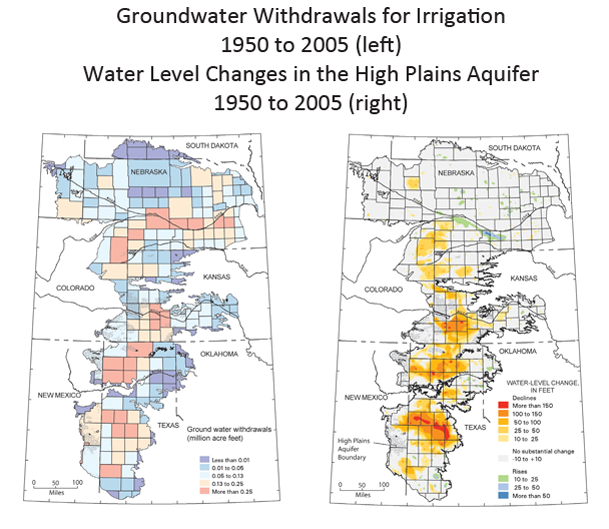 Irrigation is one of the main factors stressing water resources in the Great Plains. In parts of the region, more than 81 trillion gallons of water (pink areas on the left hand map) were withdrawn for irrigation in Texas, Oklahoma, and Kansas from 1950 to 2005. During the same time period, water levels in parts of the High Plains aquifer in those states decreased by more than 150 feet (red areas on the right hand map). Image Reference: McGuire9
Irrigation is one of the main factors stressing water resources in the Great Plains. In parts of the region, more than 81 trillion gallons of water (pink areas on the left hand map) were withdrawn for irrigation in Texas, Oklahoma, and Kansas from 1950 to 2005. During the same time period, water levels in parts of the High Plains aquifer in those states decreased by more than 150 feet (red areas on the right hand map). Image Reference: McGuire9
Projected Spring Precipitation Change by 2080s-2090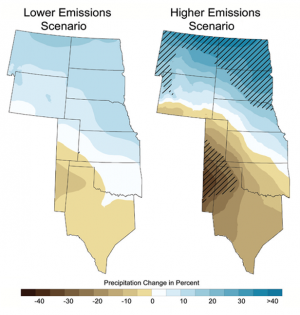 Northern areas of the Great Plains are projected to experience a wetter climate by the end of this century, while southern areas are projected to experience a drier climate. The change in precipitation is compared with a 1960-1979 baseline. Confidence in the projected changes is highest in the hatched areas. Image Reference: CMIP3-B7
Northern areas of the Great Plains are projected to experience a wetter climate by the end of this century, while southern areas are projected to experience a drier climate. The change in precipitation is compared with a 1960-1979 baseline. Confidence in the projected changes is highest in the hatched areas. Image Reference: CMIP3-B7
Average Annual Observed Precipitation (1971-2000)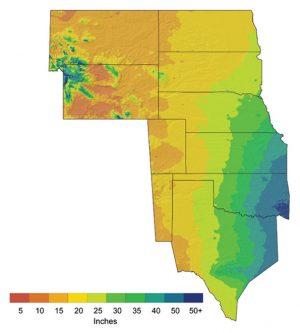 The Great Plains currently experiences a sharp precipitation gradient from east to west, from more than 50 inches of precipitation per year in eastern Oklahoma and Texas to less than 10 inches in some of the western parts of the region. Image Reference: PRISM14
The Great Plains currently experiences a sharp precipitation gradient from east to west, from more than 50 inches of precipitation per year in eastern Oklahoma and Texas to less than 10 inches in some of the western parts of the region. Image Reference: PRISM14
The Dust Bowl: Combined Effects of Land Use and Climate
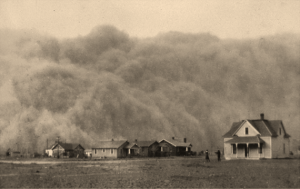 Dust Bowl of 1935 in Stratford, TexasOver the past century, large-scale conversion of grasslands to crops and ranchland has altered the natural environment of the Great Plains.5 Irrigated fields have increased evaporation rates, reducing summer temperatures, and increasing local precipitation.15,16
Dust Bowl of 1935 in Stratford, TexasOver the past century, large-scale conversion of grasslands to crops and ranchland has altered the natural environment of the Great Plains.5 Irrigated fields have increased evaporation rates, reducing summer temperatures, and increasing local precipitation.15,16
The Dust Bowl of the 1930s epitomizes what can happen as a result of interactions between climate and human activity. In the 1920s, increasing demand for food encouraged poor agricultural practices. Small-scale producers ploughed under native grasses to plant wheat, removing the protective cover the land required to retain its moisture.
Variations in ocean temperature contributed to a slight increase in air temperatures, just enough to disrupt the winds that typically draw moisture from the south into the Great Plains. As the intensively tilled soils dried up, topsoil from an estimated 100 million acres of the Great Plains blew across the continent.
The Dust Bowl dramatically demonstrated the potentially devastating effects of poor land-use practices combined with climate variability and change.17 Today, climate change is interacting with a different set of poor land-use practices. Water is being pumped from the Ogallala aquifer faster than it can recharge. In many areas, playa lakes are poorly managed (see box below). Existing stresses on water resources in the Great Plains due to unsustainable water usage are likely to be exacerbated by future changes in temperature and precipitation, this time largely due to human-induced climate change.
Agriculture
Agriculture, ranching, and natural lands, already under pressure due to an increasingly limited water supply, are very likely to also be stressed by rising temperatures.
Agricultural, range, and croplands cover more than 70 percent of the Great Plains, producing wheat, hay, corn, barley, cattle, and cotton. Agriculture is fundamentally sensitive to climate. Heat and water stress from droughts and heat waves can decrease yields and wither crops.18,19 The influence of long-term trends in temperature and precipitation can be just as great.19
As temperatures increase over this century, optimal zones for growing particular crops will shift. Pests that were historically unable to survive in the Great Plains’ cooler areas are expected to spread northward. Milder winters and earlier springs also will encourage greater numbers and earlier emergence of insects.5 Rising carbon dioxide levels in the atmosphere can increase crop growth, but also make some types of weeds grow even faster (see Agriculture sector).20
Projected increases in precipitation are unlikely to be sufficient to offset decreasing soil moisture and water availability in the Great Plains due to rising temperatures and aquifer depletion. In some areas, there is not expected to be enough water for agriculture to sustain even current usage.
With limited water supply comes increased vulnerability of agriculture to climate change. Further stresses on water supply for agriculture and ranching are likely as the region’s cities continue to grow, increasing competition between urban and rural users.21 The largest impacts are expected in heavily irrigated areas in the southern Great Plains, already plagued by unsustainable water use and greater frequency of extreme heat.5
Successful adaptation will require diversification of crops and livestock, as well as transitions from irrigated to rain-fed agriculture.22,23,24 Producers who can adapt to changing climate conditions are likely to see their businesses survive; some might even thrive. Others, without resources or ability to adapt effectively, will lose out.
Ecosystems
Climate change is likely to affect native plant and animal species by altering key habitats such as the wetland ecosystems known as prairie potholes or playa lakes.
Ten percent of the Great Plains is protected lands, home to unique ecosystems and wildlife. The region is a haven for hunters and anglers, with its ample supplies of wild game such as moose, elk, and deer; birds such as goose, quail, and duck; and fish such as walleye and bass.
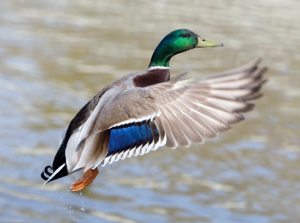 Mallard ducks are one of the many species that inhabit the playa lakes, also known as prairie potholes.Climate-driven changes are likely to combine with other human-induced stresses to further increase the vulnerability of natural ecosystems to pests, invasive species, and loss of native species. Changes in temperature and precipitation affect the composition and diversity of native animals and plants through altering their breeding patterns, water and food supply, and habitat availability.5 In a changing climate, populations of some pests such as red fire ants and rodents, better adapted to a warmer climate, are projected to increase.25,26 Grassland and plains birds, already besieged by habitat fragmentation, could experience significant shifts and reductions in their ranges.27
Mallard ducks are one of the many species that inhabit the playa lakes, also known as prairie potholes.Climate-driven changes are likely to combine with other human-induced stresses to further increase the vulnerability of natural ecosystems to pests, invasive species, and loss of native species. Changes in temperature and precipitation affect the composition and diversity of native animals and plants through altering their breeding patterns, water and food supply, and habitat availability.5 In a changing climate, populations of some pests such as red fire ants and rodents, better adapted to a warmer climate, are projected to increase.25,26 Grassland and plains birds, already besieged by habitat fragmentation, could experience significant shifts and reductions in their ranges.27
Urban sprawl, agriculture, and ranching practices already threaten the Great Plains’ distinctive wetlands. Many of these are home to endangered and iconic species. In particular, prairie wetland ecosystems provide crucial habitat for migratory waterfowl and shorebirds.
Playa Lakes and Prairie Potholes
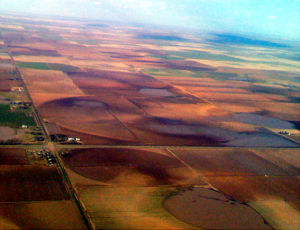 Playa lakes in west Texas fill up after a heavy spring rain.Shallow ephemeral lakes dot the Great Plains, anomalies of water in the arid landscape. In the north they are known as prairie potholes; in the south, playa lakes. These lakes create unique microclimates that support diverse wildlife and plant communities. A playa can lie with little or no water for long periods, or have several wet/dry cycles each year. When it rains, what appeared to be only a few clumps of short, dry grasses just a few days earlier suddenly teems with frogs, toads, clam shrimp, and aquatic plants.
Playa lakes in west Texas fill up after a heavy spring rain.Shallow ephemeral lakes dot the Great Plains, anomalies of water in the arid landscape. In the north they are known as prairie potholes; in the south, playa lakes. These lakes create unique microclimates that support diverse wildlife and plant communities. A playa can lie with little or no water for long periods, or have several wet/dry cycles each year. When it rains, what appeared to be only a few clumps of short, dry grasses just a few days earlier suddenly teems with frogs, toads, clam shrimp, and aquatic plants.
The playas provide a perfect home for migrating birds to feed, mate, and raise their young. Millions of shorebirds and waterfowl, including Canada geese, mallard ducks, and Sandhill cranes, depend on the playas for their breeding grounds. From the prairie potholes of North Dakota to the playa lakes of West Texas, the abundance and diversity of native bird species directly depends on these lakes.28,29
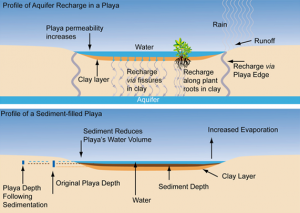 Image Source: adapted from PLJV30Despite their small size, playa lakes and prairie potholes also play a critical role in supplying water to the Great Plains. The contribution of the playa lakes to this sensitively balanced ecosystem needs to be monitored and maintained in order to avoid unforeseen impacts on our natural resources. Before cultivation, water from these lakes was the primary source of recharge to the High Plains aquifer.31 But many playas are disappearing and others are threatened by growing urban populations, extensive agriculture, and other filling and tilling practices.32 In recent years, agricultural demands have drawn down the playas to irrigate crops. Agricultural waste and fertilizer residues drain into playas, decreasing the quality of the water, or clogging them so the water cannot trickle down to refill the aquifer. Climate change is expected to add to these stresses, with increasing temperatures and changing rainfall patterns altering rates of evaporation, recharge, and runoff to the playa lake systems.33
Image Source: adapted from PLJV30Despite their small size, playa lakes and prairie potholes also play a critical role in supplying water to the Great Plains. The contribution of the playa lakes to this sensitively balanced ecosystem needs to be monitored and maintained in order to avoid unforeseen impacts on our natural resources. Before cultivation, water from these lakes was the primary source of recharge to the High Plains aquifer.31 But many playas are disappearing and others are threatened by growing urban populations, extensive agriculture, and other filling and tilling practices.32 In recent years, agricultural demands have drawn down the playas to irrigate crops. Agricultural waste and fertilizer residues drain into playas, decreasing the quality of the water, or clogging them so the water cannot trickle down to refill the aquifer. Climate change is expected to add to these stresses, with increasing temperatures and changing rainfall patterns altering rates of evaporation, recharge, and runoff to the playa lake systems.33
Society
Ongoing shifts in the region’s population from rural areas to urban centers will interact with a changing climate, resulting in a variety of consequences.
Inhabitants of the Great Plains include a rising number of urban dwellers, a long tradition of rural communities, and extensive Native American populations. Although farming and ranching remain primary uses of the land – taking up much of the region’s geographical area – growing cities provide housing and jobs for more than two-thirds of the population. For everyone on the Great Plains, though, a changing climate and a limited water supply are likely to challenge their ability to thrive, leading to conflicting interests in the allocation of increasingly scarce water resources.34,21
Native American communities
The Great Plains region is home to 65 Native American tribes. Native populations on rural tribal lands have limited capacities to respond to climate change.34 Many reservations already face severe problems with water quantity and quality – problems likely to be exacerbated by climate change and other human-induced stresses.
Rural communities
As young adults move out of small, rural communities, the towns are increasingly populated by a vulnerable demographic of very old and very young people, placing them more at risk for health issues than urban communities. Combined effects of changing demographics and climate are likely to make it more difficult to supply adequate and efficient public health services and educational opportunities to rural areas. Climate-driven shifts in optimal crop types and increased risk of drought, pests, and extreme events will add more economic stress and tension to traditional communities.18,21
Urban populations
Although the Great Plains is not yet known for large cities, many mid-sized towns throughout the region are growing rapidly. One in four of the most rapidly growing cities in the nation is located in the Great Plains35 (see Society sector). Most of these growing centers can be found in the southern parts of the region, where water resources are already seriously constrained. Urban populations, particularly the young, elderly, and economically disadvantaged, may also be disproportionately affected by heat.36
New opportunities
There is growing recognition that the enormous wind power potential of the Great Plains could provide new avenues for future employment and land use. Texas already produces the most wind power of any state. Wind energy production is also prominent in Oklahoma. North and South Dakota have rich wind potential.37
As climate change creates new environmental conditions, effective adaptation strategies become increasingly essential to ecological and socioeconomic survival. A great deal of the Great Plains’ adaptation potential might be realized through agriculture. For example, plant species that mature earlier and are more resistant to disease and pests are more likely to thrive under warmer conditions.
Other emerging adaptation strategies include dynamic cropping systems and increased crop diversity. In particular, mixed cropping-livestock systems maximize available resources while minimizing the need for external inputs such as irrigation that draws down precious water supplies.24 In many parts of the region, diverse cropping systems and improved water use efficiency will be key to sustaining crop and rangeland systems.38 Reduced water supplies might cause some farmers to alter the intensive cropping systems currently in use.39,40
Adaptation: Agricultural Practices to Reduce Water and Soil Erosion
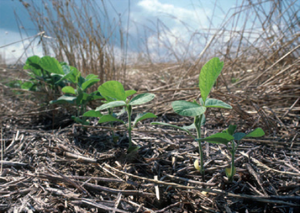 Conservation of water is critical to efficient crop production in areas where water can be scarce. Following the Dust Bowl in the 1930s, Great Plains farmers implemented a number of improved farming practices to increase the effectiveness of rainfall capture and retention in the soil and protect the soil against water and wind erosion. Examples include rotating crops, retaining crop residues, increasing vegetative cover, and altering plowing techniques.
Conservation of water is critical to efficient crop production in areas where water can be scarce. Following the Dust Bowl in the 1930s, Great Plains farmers implemented a number of improved farming practices to increase the effectiveness of rainfall capture and retention in the soil and protect the soil against water and wind erosion. Examples include rotating crops, retaining crop residues, increasing vegetative cover, and altering plowing techniques.
With observed and projected increases in summer temperatures and in the frequency and intensity of heavy downpours, it will become even more important to protect against increasing loss of water and soil. Across the upper Great Plains, where strong storms are projected to occur more frequently, producers are being encouraged to increase the amount of crop residue left on the soil or to plant cover crops in the fall to protect the soil in the spring before crops are planted.
Across the southern Great Plains, some farmers are returning to dryland farming rather than relying on irrigation for their crops. Preserving crop residue helps the soil absorb more moisture from rain and eases the burden on already-stressed groundwater. These efforts have been promoted by the U.S. Department of Agriculture through research and extension efforts such as Kansas State University’s Center for Sustainable Agriculture and Alternative Crops.
References
- 1. [93] various. footnote 93., 2009.
- 2. [97] Cook, E. R., P. J. Bartlein, N. S. Diffenbaugh, R. Seager, B. N. Shuman, R. S. Webb, J. W. Williams, and CA Woodhouse. "Hydrological Variability and Change." In Abrupt Climate Change, 143-257. Vol. Synthesis and Assessment Product 3.4. Reston, VA: U.S. Geological Survey, 2008.
- 3. [419] Woodhouse, CA, and J. T. Overpeck. "2000 Years of Drought Variability in the Central United States." Bulletin of the American Meteorological Society 79, no. 12 (1998): 2693-2714.
- 4. [420] DeGaetano, A. T., and R. J. Allen. "Trends in Twentieth-century Temperature Extremes across the United States." Journal of Climate 15, no. 22 (2002): 3188-3205.
- 5. a. b. c. d. e. f. [149] Lettenmaier, D., D. Major, L. Poff, and S. Running. "Water Resources." In The Effects of Climate Change on Agriculture, Land Resources, Water Resources and Biodiversity in the United States, edited by P. Backlund, A. Janetos, D. Schimel, J. Hatfield, K. Boote, P. Fay, L. Hahn, C. Izaurralde, B. A. Kimball, T. Mader et al., 121-150. Vol. Synthesis and Assessment Product 4.3. Washington, D.C.: U.S. Department of Agriculture, 2008.
- 6. [421] Garbrecht, J., M. Van Liew, and G. O. Brown. "Trends in Precipitation, Streamflow, and Evapotranspiration in the Great Plains of the United States." Journal of Hydrologic Engineering 9, no. 5 (2004): 360-367.
- 7. a. b. [117] various. footnote 117., 2009.
- 8. [108] Christensen, J. H., B. Hewitson, A. Busuioc, A. Chen, X. Gao, R. Held, R. Jones, R. K. Kolli, W. - T. Kwon, R. Laprise et al. "Regional climate projections." In Climate Change 2007: The Physical Science Basis, edited by S. Solomon, D. Qin, M. Manning, Z. Chen, M. Marquis, K. B. Averyt, M. Tignor and H. L. Miller, 847-940. Vol. Contribution of Working Group I to the Fourth Assessment Report of the Intergovernmental Panel on Climate Change. Cambridge UK and New York, NY: Cambridge University Press, 2007.
- 9. a. b. [422] McGuire, V.. Water-level Changes in the High Plains Aquifer, Predevelopment to 2005 and 2003 to 2005 In U.S. Geological Survey Scientific Investigations Report 2006-5324. Reston, VA: U.S. Geological Survey, 2007.
- 10. [423] Dennehy, K.. High Plains Regional Ground-water Study. Vol. Fact Sheet. U.S. Geological Survey, 2000.
- 11. [253] Backlund, P., D. Schimel, A. Janetos, J. Hatfield, M. G. Ryan, S. R. Archer, and D. Lettenmaier. "Introduction." In The Effects of Climate Change on Agriculture, Land Resources, Water Resources, and Biodiversity in the United States, edited by P. Backlund, A. Janetos, D. Schimel, J. Hatfield, K. Boote, P. Fay, L. Hahn, C. Izaurralde, B. A. Kimball, T. Mader et al., 11-20. Vol. Synthesis and Assessment Product 4.3. Washington, D.C.: U.S. Department of Agriculture, 2008.
- 12. [424] Gurdak, J. J., R. T. Hanson, P. B. McMahon, B. W. Bruce, J. E. McCray, G. D. Thyne, and R. C. Reedy. "Climate Variability Controls on Unsaturated Water and Chemical Movement, High Plains Aquifer, USA." Vadose Zone Journal 6, no. 3 (2007): 533-547.
- 13. [425] Green, T. R., M. Taniguchi, and H. Kooi. "Potential Impacts of Climate Change and Human Activity on Subsurface Water Resources." Vadose Zone Journal 6, no. 3 (2007): 531-532.
- 14. [426] various. footnote 426., 2009.
- 15. [427] Mahmood, R., S. A. Foster, T. Keeling, K. G. Hubbard, C. Carlson, and R. Leeper. "Impacts of Irrigation on 20th Century Temperature in the Northern Great Plains." Global and Planetary Change 54, no. 1-2 (2006): 1-18.
- 16. [428] Moore, N., and S. Rojstaczer. "Irrigation's Influence on Precipitation: Texas High Plains, USA." Geophysical Research Letters 29, no. 16 (2002): -.
- 17. [429] Schubert, S. D., M. J. Suarez, P. J. Pegion, R. D. Koster, and J. T. Bacmeister. "On the Cause of the 1930s Dust Bowl." Science 303, no. 5665 (2004): 1855-1859.
- 18. a. b. [430] Motha, R. P., and W. Baier. "Impacts of Present and Future Climate Change and Climate Variability on Agriculture in the Temperate Regions: North America." Climatic Change 70, no. 1-2 (2005): 137-164.
- 19. a. b. [431] Izaurralde, R. C., N. J. Rosenberg, R. A. Brown, and A. M. Thomson. "Integrated Assessment of Hadley Center (HadCM2) Climate-change Impacts on Agricultural Productivity and Irrigation Water Supply in the Conterminous United States: Part II. Regional Agricultural Production in 2030 and 2095." Agricultural and Forest Meteorology 117, no. 1-2 (2003): 97-122.
- 20. [432] Ziska, L., and K. George. "Rising Carbon Dioxide and Invasive, Noxious Plants: Potential Threats and Consequences." World Resource Review 16 (2004): 427-447.
- 21. a. b. c. [433] Parton, W. J., M. P. Gutmann, and D. Ojima. "Long-term Trends in Population, Farm Income, and Crop Production in the Great Plains." BioScience 57, no. 9 (2007): 737-747.
- 22. [434] Reilly, J., F. Tubiello, B. McCarl, D. Abler, R. Darwin, K. Fuglie, S. Hollinger, C. Izaurralde, S. Jagtap, J. Jones et al. "U.S. Agriculture and Climate Change: New Results." Climatic Change 57, no. 1-2 (2003): 43-69.
- 23. [435] Allen, V. G., C. P. Brown, R. Kellison, E. Segarra, T. Wheeler, P. A. Dotray, J. C. Conkwright, C. J. Green, and V. Acosta-Martinez. "Integrating Cotton and Beef Production to Reduce Water Withdrawal from the Ogallala Aquifer in the Southern High Plains." Agronomy Journal 97, no. 2 (2005): 556-567.
- 24. a. b. [436] Hanson, J. D., M. A. Liebig, S. D. Merrill, D. L. Tanaka, J. M. Krupinsky, and D. E. Stott. "Dynamic Cropping Systems: Increasing Adaptability amid an Uncertain Future." Agron Journal 99, no. 4 (2007): 939-943.
- 25. [437] Cameron, G. N., and D. Scheel. "Getting Warmer: Effect of Global Climate Change on Distribution of Rodents in Texas." Journal of Mammalogy 82, no. 3 (2001): 652-680.
- 26. [438] Levia, D. F., and E. E. Frost. "Assessment of Climatic Suitability for the Expansion of Solenopsis invicta Buren in Oklahoma Using Three General Circulation Models." Theoretical and Applied Climatology 79, no. 1-2 (2004): 23-30.
- 27. [439] Peterson, A. T.. "Projected Climate Change Effects on Rocky Mountain and Great Plains Birds: Generalities of Biodiversity Consequences." Global Change Biology 9, no. 5 (2003): 647-655.
- 28. [440] Niemuth, N. D., and J. W. Solberg. "Response of Waterbirds to Number of Wetlands in the Prairie Pothole Region of North Dakota, USA." Waterbirds 26, no. 2 (2003): 233-238.
- 29. [441] Conway, W. C., L. M. Smith, and J. D. Ray. "Shorebird Breeding Biology in Wetlands of the Playa Lakes, Texas, USA." Waterbirds 28, no. 2 (2005): 129-138.
- 30. [445] Venture, Playa Lakes Joint. Playas and the Ogallala Aquifer - What's the Connection?. Lafayette, CO: Playa Lakes Joint Venture, Submitted.
- 31. [442] Scanlon, B. R., R. C. Reedy, and J. Tachovsky. "Semiarid Unsaturated Zone Chloride Profiles: Archives of Past Land Use Change Impacts on Water Resources in the Wouthern High Plains, United States." Water Resources Research 43 (2007).
- 32. [443] Haukos, D. A., and L. M. Smith. "Past and Future Impacts of Wetland Regulations on Playa Ecology in the Southern Great Plains." Wetlands 23, no. 3 (2003): 577-589.
- 33. [444] Matthews, J.. Anthropogenic Climate Change in the Playa Lakes Joint Venture Region: Understanding Impacts, Discerning Trends, and Developing Responses. Lafayette, CO: Playa Lakes Joint Venture, 2008.
- 34. a. b. [313] Wilbanks, T. J., P. Kirshen, D. Quattrochi, P. Romero-Lankao, C. Rosenzweig, M. Ruth, W. D. Solecki, J. Tarr, P. H. Larsen, and B. Stone. "Effects of Global Change on Human Settlements." In Analyses of the Effects of Global Change on Human health and Welfare and Human Systems, edited by J. L. Gamble, 89-109. Vol. Synthesis and Assessment Product 4.6. Washington, D.C.: U.S. Environmental Protection Agency, 2008.
- 35. [446] Bureau, Census U. S.. Census Bureau Announces Most Populous Cities., 2007.
- 36. [447] Ebi, K. L., D. M. Mills, J. B. Smith, and A. Grambsch. "Climate Change and Human Health Impacts in the United States: An Update on the Results of the U.S. National Assessment." Environmental Health Perspectives 114, no. 9 (2006): 1318-1324.
- 37. [191] Bull, S. R., D. E. Bilello, J. Ekmann, M. J. Sale, and D. K. Schmalzer. "Effects of Climate Change on Energy Production and Distribution in the United States." In Effects of Climate Change on Energy Production and Use in the United States, edited by T. J. Wilbanks, V. Bhatt, D. E. Bilello, S. R. Bull, J. Ekmann, W. C. Horak, Y. J. Huang, M. D. Levine, M. J. Sale, D. K. Schmalzer et al., 45-80. Vol. Synthesis and Assessment Product 4.5. Washington, D.C.: U.S. Climate Change Science Program, 2007.
- 38. [448] Nielsen, D. C., P. W. Unger, and P. R. Miller. "Efficient Water Use in Dryland Cropping Systems in the Great Plains." Agronomy Journal 97, no. 2 (2005): 364-372.
- 39. [193] Hatfield, J., K. Boote, P. Fay, L. Hahn, C. Izaurralde, B. A. Kimball, T. Mader, J. Morgan, D. Ort, W. Polley et al. "Agriculture." In The Effects of Climate Change on Agriculture, Land Resources, and Biodiversity in the United States, edited by P. Backlund, A. Janetos, D. Schimel, J. Hatfield, K. Boote, P. Fay, L. Hahn, C. Izaurralde, B. A. Kimball, T. Mader et al., 21-74. Vol. Synthesis and Assessment Product 4.3. Washington, D.C.: U.S. Department of Agriculture, 2008.
- 40. [219] Team, National Assessment Synthesis. Climate Change impacts on the United States: The Potential Consequences of Climate Variability and Change. Cambridge, UK and New York, NY, 2001.